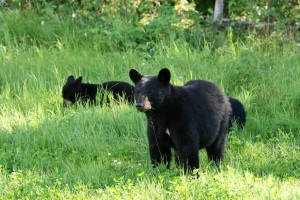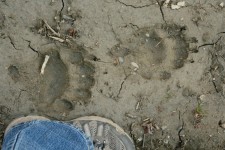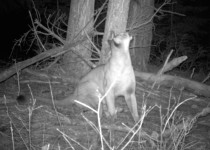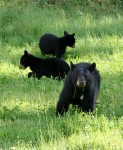Seeing bear tracks in the trail provides a heads-up that a bear is in the area. However, surprise encounters can happen if the bear can’t smell you because of the wind or its attracted to food or garbage odors. Most surprise encounters do not result in physical attacks, especially if the group has more than three hikers. Bears usually only attack if they feel threatened or provoked.
To minimize the chance of an attack, stay calm and don’t run. Running encourages a bear to chase and grizzly bears can run fast–50 yards in three seconds or 40 mph.

The most dangerous type of encounter is a sow with cubs. Never position yourself between a sow and her cubs or approach them.
Pick up small children immediately, keep in a group and have bear pepper spray out and ready (and know how to use it).
The advice to climb a tree isn’t the best because grizzly bears can climb trees like black bears. Unless you can climb higher than ten feet before the grizzly bear reaches the tree, Montana Fish Wildlife and Park officials urge against climbing a tree.
Behave in a non-threatening manner which includes not making eye contact. Definitely keep an eye on the bear but don’t make eye contact.
Also talk softly and calmly at the bear to identify yourself as a person. Screaming or squealing can trigger an attack because they can sound like an animal in distress–an easy meal for a bear.
Slowly wave your arms as you move away slowly. Sudden movements can trigger an attack. You want to leave the area immediately but in a slow manner. Instead of backing up, move sideways so you can keep an eye on the bear and avoid tripping over objects on the ground. If you have to go in the direction of the bear, detour the best you can with at least 100 yards between you and the bear or back down the trail and wait awhile until trying again.
Bear experts also recommend dropping a non-food item (like a hat or mitten) on the ground in front of you before you back away as a distraction.
Grizzly bears may stand on their hind legs to get a better view of you but the posture isn’t a threat or signal its going to charge. The bear may huff or growl as a threat display and then in most cases it will leave.
To communicate dominance bears may snort, salivate or snap their jaws to scare you away. Bears may also scare you away with bluff charges which means they run towards you but veer or stop short of you at the last second. Bluff charges and real charges can be difficult to distinguish but bluff charges usually occur with a hopping or bounding motion with the bear’s head up, legs stiff and ears forward according to the U.S. Fish and Wildlife Service.
Whether real charge or bluff charge, remain standing with your pepper spray or weapon ready. Charging grizzlies may run past you or veer away.
Bear experts say pepper spray is the best deterrent against a bear attack if used properly. You need to know the wind direction and spray at the recommended distance–30 to 60 feet away. The cloud of capsaicin can give you a few minutes to exit the area quickly (but don’t run) while it temporarily causes a burning sensation in the bear’s eyes.
Bear experts say wounding a bear can put you in far greater danger because the bear can live long enough to inflict serious injury. Montana Fish Wildlife and Parks officials say that if you have a weapon, know how to safely and effectively use it because wounding a grizzly bear will put you and others in danger.
If pepper spray or a weapon doesn’t work or if you don’t have either and the bear makes physical contact, drop to the ground for a grizzly bear. Leave your backpack on, clasp your hands behind your head and play dead with your legs spread out in order to make it harder for the bear to turn you over. Play dead until you are sure the bear is gone and make no noise.
If the attack persists, the bear may be in predatory mode and experts recommend fighting back by hitting the bear in the face with whatever you have (hiking stick, rocks). Predatory bears typically keep their ears erect, don’t exhibit warning signs and are visually locked on their victim before the attack.
Also fight back if the attack is by a black bear. Concentrate hitting the bear in the face and muzzle with whatever object is available until the bear is scared away, overpowered, injured or killed.
Rehearsing scenarios is the best way to be prepared in bear country. Know bear sign and know the difference between a black bear and a grizzly bear. To put bear attacks into perspective, the Wildlife Research Institute complied some statistics. In North America, one black bear out of a million kills someone and one grizzly bear out of 50,000 kills someone.
For each fatal black bear attack on a human, there are 13 deaths by snakebite, 45 deaths by dogs, 120 deaths by bee or hornet stings, 249 deaths by lightning and 120,000 traffic deaths.
Bear encounters are a reality but so are bee stings, so it is best to be prepared and hope for neither to occur.




